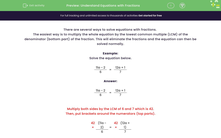There are several ways to solve equations with fractions.
The easiest way is to multiply the whole equation by the lowest common multiple (LCM) of the denominator (bottom part) of the fraction. This will eliminate the fractions and the equation can then be solved normally.
Example:
Solve the equation below.
| 11a - 2 | = | 12a + 1 |
| 6 | 7 |
Answer:
| 11a - 2 | = | 12a + 1 |
| 6 | 7 |
Multiply both sides by the LCM of 6 and 7 which is 42.
Then, put brackets around the numerators (top parts).
| 42 × | (11a - 2) | = | 42 × | (12a + 1) |
| 6 | 7 |
Reduce the fractions:
| 7 |
(11a - 2) | = | 6 |
(12a + 1) |
Simplify:
7 (11a - 2) = 6 (12a + 1)
Multiply out the brackets:
77a - 14 = 72a + 6
Add 14 to both sides:
77a - 14 + 14 = 72a + 6 + 14
Simplify:
77a = 72a + 20
Subtract 72a from both sides:
77a -72a = 72a + 20 - 72a
Simplify:
5a = 20
Divide both sides by 5:
5a ÷ 5 = 20 ÷ 5
Simplify:
a = 4
Ensure you have a pen and paper so that you can write down your working out. This will enable you to spot any errors and, even if you get the final answer incorrect in your exams you may still gain valuable marks.







